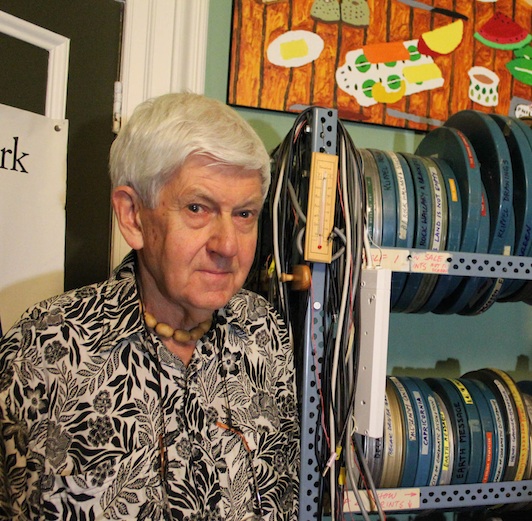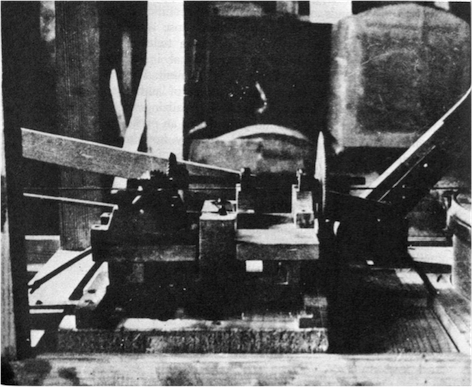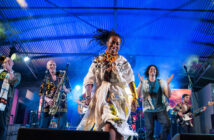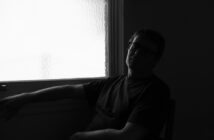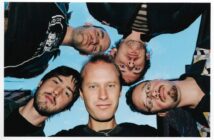Australian born Arthur Cantrill has made upwards of 150 films with his wife Corinne Cantrill since 1960 – including seven feature length films. Initially beginning with films for children and documentaries on art, they’ve increasingly created experimental avant garde art films, working predominantly in the 16mm and Super 8 formats, though also creating multi screen projections and one off ‘film performance works’ of expanded cinema, where the film would be projected within a set, bringing in trees, rocks and sand to create a landscape that would shadow the edge of the film. Their works are highly immersive multi sensory experiences, focussing on landscape, color, light, and the history and technology of film.
Their work has been exhibited worldwide including the Centre Pompidou and The Louvre in Paris, the New York Museum of Modern Art, as well as other art museums and film festivals. Cantrill has also held the post of Associate Professor in the School of Creative Arts, University of Melbourne, received a fellowship at ANU in Canberra and taught at Penn State University.
Cantrill began producing soundtracks to his films when their first films were given the narration and “canned’ music treatment by the ABC. Cantrill felt that he could do better, so improvising on a variety of toy instruments, a wooden xylophone received as a birthday gift, and prepared piano, he began to record environmental sounds, using musique concrete/tape techniques, and collage to create their distinctive pieces.
In recent years Arthur Cantrill’s unique soundscapes have been increasingly recognised for their contribution to the development of Australian experimental music, with 2010’s compilation of his work, Chromatic Mysteries: Soundtracks 1963-2009 and the recently released LP Hootonics, issued on Melbourne label Shame File Music.
With such a unique broad ranging sound palette that incorporates such a diversity of approaches, Cyclic Defrost took the opportunity to ask Cantrill about some of the works that have influenced him throughout his career.
Daphne Oram – Private Dreams and Public Nightmares, a Radiophonic poem (poem written by Frederick Bradman) .
In 1963 I made my first experimental film soundtrack, Mud, a four-minute piece to accompany close up shots of bubbling mud shot in Rotorua, New Zealand, suggesting the beginning of the world. I’m not sure which came first, but about the same time I heard an experimental sound piece from the BBC Radiophonic Workshop: Private Dreams and Public Nightmares, broadcast out of the blue one afternoon by ABC radio. I was astonished that the ABC would broadcast such an innovative piece, and it reinforced my desire to push into experimental sound compositon for our films. Listening to it again now I’m surprised at how little music there is in it, although there is electronic treatment of the spoken voice.
Daphne Oram, who had studied electronics and music, had been experimenting with electronic sound at the BBC in the 1940s. Encouraged by the support RTF (Radiodiffusion-Télévision Française) gave to electronic music, she convinced the BBC to set up a studio for audio experiment in 1958 which became the Radiophonic Workshop . (ORTF, as it became, later supported the work of Pierre Schaeffer, whom I met when we visited Paris in 1966.)
My first semi-professional reel-to-reel machine was a mono Ferrograph, bought in the late 1950s, which I later used with a Nagra. A photograph shows Oram working with three Ferrograph tape recorders and tape loops at the BBC. One account of her work tells that the BBC reluctantly gave her some outdated equipment to use in her studio, and by then the Ferrograph had generally been superseded. Oram soon left the BBC, frustrated at their limited expectation that she was there just to provide Doctor Who-type music and effects. She set up her own studio and invented a range of techniques for producing experimental music, which she called Oramics.
She is a significant pioneer of electronic music composition.
Oramics a double CD released by Sinetone AMR in 2012, has experimental pieces such as Four Aspects as well as her work for commercials.
When I was film editing at the BBC in the late 1960s, I asked the Radiophonic Workshop to provide some shimmering sound to go with a sequence of heat shimmer on an aircraft carrier deck. It was effective, but I was disappointed that they didn’ compose something special, simply providing a piece from their existing catalogue!
La Monte Young – Live in London 1965
A particularly formative experience for me was attending a La Monte Young performance in 1965 in London that demonstrated his interest in repetition and duration. A piano note was repeatedly struck over a long duration (not sure how long – “time’ began to be redefined) until new harmonics seemed to grow, and the sound resonated in the head in a totally unexpected way. Young is known as a pioneer of “minimalism”, but there was nothing minimal in this performance – he says, “I have my own definition of minimalism, which is that which is created with a minimum of meansâ€.
Young speaks of his desire to “get inside the sound†until one feels one is leaving “this world†and “stepping into the world of the soundâ€. For Gertrude Stein there was no such thing as exact repetition – every time we experience a repeated word or sound we experience it slightly differently due to our changing attitude to it. With Young the differences accumulated until the original sound took on new qualities. “I am wildly interested in repetition. “ he said, “because I think it demonstrates control.â€
His work continues to influence me, especially the drone music compositions such as The Tortoise, His Dream and Journeys, performed by his Theatre of Eternal Music ensemble in the 1960s, which included Tony Conrad. As Young’ performances can last five or six hours there are few discs of his work, and those that are available are usually extracts or short pieces such as the bowed gong piece The Volga Delta on “The Black Disc’, an LP published by Edition X, Germany, in 1969.
George Antheil- Ballet mécanique (Music Masters Classics)
Georges Antheil, avant-garde American composer living in Paris in 1924, wanted a film to be made to his composition, “Ballet mécanique’. Fellow American artist Man Ray shot some material for it but pulled out of the project when he realised he would have to foot the bill, and painter Fernand Léger took it on, assisted technically by American filmmaker Dudley Murphy. So it was very much a group project, and this is reflected in its uneveness.
Antheil’ composition was quite avant-garde for 1924, involving eight synchronised player pianos (prefiguring computer-controlled music performance), much percussion and siren and aeroplane effects, and does much to enhance the film. I heard the music first in 1972 when US film scholar, the late William Moritz, gave me a tape of it to go with the silent print of the film we had just bought in Los Angeles, but a better recording of the music appeared in 1992.
The CD has other Antheil pieces such as A Jazz Symphony that I’ve found goes well with Man Ray’ 1923 film Return to Reason.
Jack Ellitt- Tusalava (lost score for an animated Len Lye film) (1929) Light Rhythms
Jack Ellitt was a Sydney composer who moved to London in 1927 and, became involved with New Zealand artist Len Lye’ filmmaking as sound editor and composer. Tusalava was scored for two pianos, but it was never performed to Ellitt’s satisfaction, and he destroyed the score after the premiere. We can get an idea of how it would have sounded from his second film composition for piano, Light Rhythms, for a film by American-born artist Francis Bruguiere . It’s a vigorous modernist piece, apparently inspired by Stravinsky’ repetitions, unexpected rhythms and dissonances, as well as the music of the Russian Futurist composer, Alexandr Mosolov, whose Iron Foundry comes close to being noise music, in its evocation of the percussive effects and repeated mechanical sounds of a foundry. In Light Rhythms Ellitt supports and follows the patterns of rhythm in the abstract images of light playing over Bruguiere’ paper sculptural forms, while adding new repeated rhythms and textures of sound in counterpoint, enriching the audio-visual experience. There are similarities to George Antheil’ Ballet mécanique. Ellitt developed a theory and practice of experimental “sound constructions’ – “. . . a construction of selected sound colours used irrespectively of any of those laws and dogmas of harmonic and melodic progression which have until recently been inherent in all forms of musicâ€. Some of this work can be heard on the CD: Jack Ellitt – Sound Constructions published by Shame File Music. He continued experimenting with sound back in Australia until the 1990s, and died in 2001. (See Cantrills Filmnotes, #93-100, pp 22-26.)
Sonny Terry- Fox Hunt (aka “Fox Chase’) Back to New Orleans Fantasy, Inc. (It can be heard on Len Lye film Color Cry.)
Len Lye used Fox Hunt, recorded by blind Afro-American blues harmonica player and vocalist Sonny Terry, to accompany his hand-printed and painted abstract film Color Cry (1952). As Lye said, the music “fitted like madâ€. Terry alternates the fast harmonica riffs with his vocalization of the howls of hunting dogs, or, as Lye speculated, the cries of a victim of a Southern lynch mob being pursued. There’ a compelling, breathtaking panicky, visceral quality to it.
Lye spoke of the organic nature of the abstract hand-painted and hand-printed images (made by contact-printing objects and transparent or textured coloured materials onto the film stock) as evoking “blood cells, nerves, bone and marrow, rib-cage, sinews,’ and he thought of the raw music as a “forced death dirge’. Lye paid Terry for the music rights.
Walter Ruttman- Weekend (Wochenende)
German experimental and documemtary filmmaker Walter Ruttman put together this eleven-minute sound collage in 1930 to evoke weekend leisure activities in Berlin – travelling, entertainment etc. It was commissioned and broadcast by Berlin radio. It was an audio sequel to his ground-breaking silent film, Berlin – Symphony of a Great City, made in 1927.
As magnetic recording systems were not yet available, Ruttmann recorded the sound on 35mm optical sound film and edited it as a film sound editor would, joining the sometimes quite short pieces of sound effects, music and voices with splicing cement, sometimes reversing the sound. The clicks made by the overlapping splices had to be “blooped out’s with opaque black ink. In a 1929 manifesto he wrote “Everything audible in the world becomes material’, thus prefiguring the musique concrète methods of Pierre Schaeffer and others. A section from the Weekend “score’ shows a voice repeatedly saying “see you later’ and key, lock and a rattling bunch of keys, suggesting leaving for a weekend trip:
Jimi Hendrix – Woodstock – Star Spangled Banner track (Polydor)
When I first heard this recording made at Woodstock in 1969 I felt that pop had met experimental music in a strong anti-war statement, in particular anti-Vietnam war. The distorted screams of napalm victims and the roar of aircraft, rockets and guns emerge from the once-patriotic melody with fierce satirical effect. The solo performance, unmediated by any accompaniment, made it a passionate, but cool personal statement.
Mauricio Kagel – Antithese – Ludwig van (Deutsche-Grammophon LP, 1970)
I discovered Kagel’ film Antithese in the early 1960s, soon after it was made. We often borrowed the 16mm print from the German embassy in Canberra and showed it to classes and workshops. It’s in the tradition of his “music-theatre’ where performance is combined with experimental music, and it influenced the “film-theatre’ pieces we presented at La Mama theatre, Carlton, from the mid-1970s. (We also saw some short Kagel music-films at the Knokke experimental film festival, Belgium, in 1967.)
In Antithese (“a film for an actor, with electronic and musical sounds’) Argentinian-German composer Kagel is seen exploring and interacting with a space filled with machinery, cables, television monitors, masses of audio tape, as though he is trapped in a world of audio-visual technology. It begins with Kagel chalking a complex diagram of the piece on a gigantic chalkboard. Then, dressed in a dustcoat, he begins dismantling the complex installation – unplugging and pulling out cables, pushing through masses of quarter-inch audiotape. There’ an absurdist, even surrealist quality, and the sense of a critique of the state of music and its interaction with recording media. Later he’ dragging, with some difficulty, a large piece of equipment against a matted-in forest background. This scene appears on a television monitor in the original space, with the “real’ Kagel watching. Both Kagels pull out a gun and aim at the other, but the “real’ Kagel shoots first at the TV screen, then smashes the TV to pieces.”
Another Kagel piece that has influenced our work is the Ludwig van composition on LP, which started out as a live performance done in a set that was a reproduction of Beethoven’ room in Bonn, the walls and furniture papered with Beethoven scores. The musicians played (with some difficulty) from the cut-up scores, which went round corners of the furniture and the piano etc. It also existed as a 1969 film (now on Youtube). The 1970 LP is a collage of many orchestral extracts from Beethoven, analysed and reworked, “recomposed’, with some humour, to update the music in a modernist style.
Kagel, who died in 2008, has been a continuing inspiration for us in his multimedia approach to the material.
Francesco Pratella – L’aviatore Dro (1914 opera) fragment, with Luigi Russolo’ Futurist noise machines – Musik um den Futurismus Akademie der Künste LP
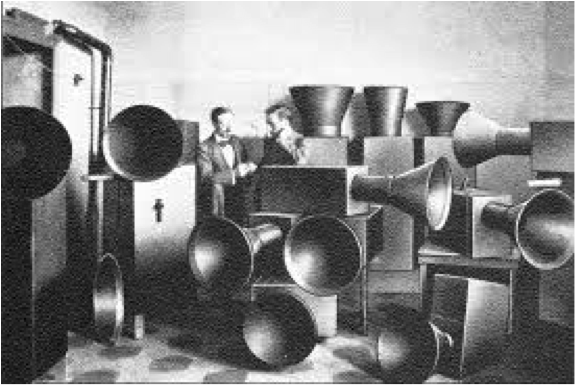
With his noise machines, the “intonarumoriâ€(noise-intoners), the Italian Futurist Luigi Russolo could be said to have pioneered noise music. In a 1913 manifesto he stated that as the industrial revolution had made us accustomed to more complex mechanical noises they could now be composed and would eventually replace traditional music. In a 1914 intonarumori concert Russolo and Marinetti presented such pieces as Awakening of a City and Meeting of Cars and Aeroplanes. A music critic, writing about a London concert, referred to the participants as “noisiciansâ€! Luigi’ brother, Antonio, made a 78 record of two pieces of rather conventional music with noise machine accompaniment, Corale and Serenata, in 1921, but more effective use is in a 1980 LP of a Futurist concert published by the Akademie der Künste, which we found in Berlin, with an excerpt from Pratella’ 1914 opera l’aviatore Dro. (Pratella was considered by Russolo as the most advanced of the Futurist composers.) The LP uses modern recreations of the intonarumori, as the originals have disappeared. Inside the box is a mechanism, worked by a lever, that activated a stretched membrane in various ways. Pitch could be varied by sliding a lever. Each instrument had a unique repertoire of sound. This shows the mechanism:
After years of wondering how the mythical Russolo noise machines sounded, at last with the Akademie der Künste LP we had something to listen to. Since then, various examples have appeared on Youtube.
Frank Zappa- 200 Motels (Rykodisc 1997)
I have to get Frank Zappa and his Mothers of Invention into this list somehow, as I’ve loved their work since I first heard it in the early 1970s. Some of it I think of as a kind of intellectual updating of Spike Jones and His City Slickers (which I loved as a kid in the 1940s) – dada-like, self-reflexive satirical irreverence. I’ll represent his prolific output with 200 Motels for its combination of a rock band with a symphony orchestra (sending up both), and its depiction of the horrors of touring. (It reminds me of a screening tour of Europe in 2001 that Corinne and I did, a one-night stand in each of eleven cities.) The film’ craziness is supposed to reflect the madness induced in the group by the experience.
I wasn’ impressed with the film 200 Motels – I thought it should have had more time spent on it; it was shot in a week at Pinewood Studios, England – but the CD based on the soundtrack I think is successful. Their following album, Just Another Band from LA owes a lot to 200 Motels and has the hilarious send-up of rock operas: Billy the Mountain.
More information can be found about Arthur and Corinne’s work at their website. Whilst Arthur’s music is available at Shame File Music

